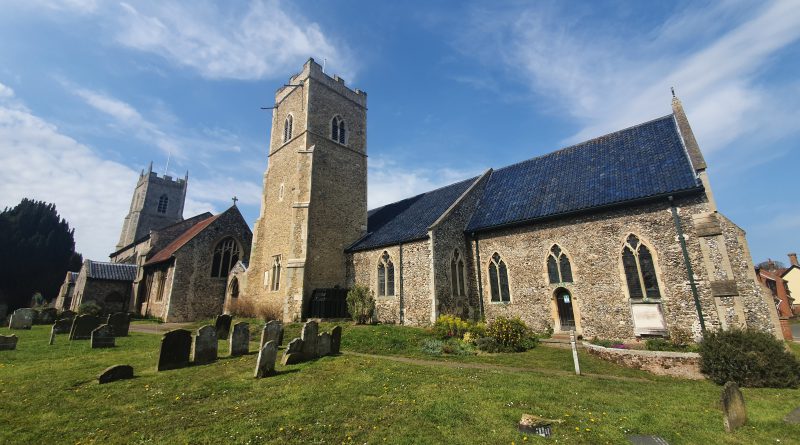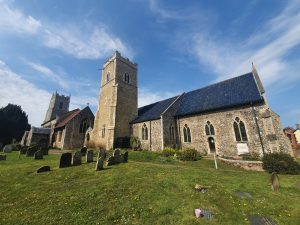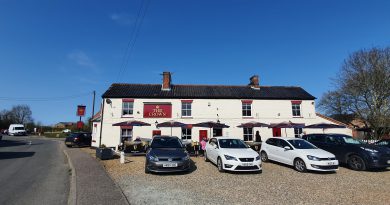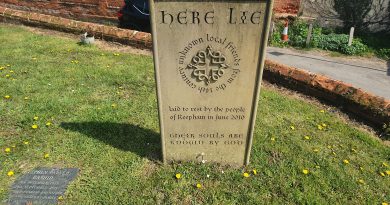Reepham – Three Churches in One Churchyard
This is the delightful churchyard in Reepham, home of St. Michael’s church of Whitwell parish, St. Mary’s church of Reepham parish and All Saints of Hackford parish. The first two are still standing and in the first photo there’s St. Michael’s on the left and St. Mary’s on the right, and in the second photo, there’s the remains of All Saints on the right and St. Michael’s is in the centre of the photo.
It’s not entirely clear why three parish churches were all built in the same churchyard, but this all likely revolves around the very different way in which these buildings were once used. An information panel at the church notes that pews were introduced in the Tudor period as there was a fashion for longer services. I’m not entirely sure about that, I’d go for that it was less fashion and more a requirement of the new regime following the Restoration to ensure people actually went to church.
But all of this is why these churches could be built next to each other, something that actually makes sense, as it’s a prominent location and land was available to build them on. There was probably some form of religious element to the location as well, perhaps some miracle had taken place on the site and it had a reputation for being a holy site. The churches are all on the very edge of their parishes, but they wouldn’t have necessarily competed as they would have been used more for private prayer, for meeting up or just for wealthier individuals to buy indulgences or have a private family chapel. Individuals weren’t required to go to the church, although there was more of a expectation to do something at Easter, and they would have been more of a community centre.
All Saints was likely the first church to be built on this site as it’s the only one mentioned in the Domesday Book, probably in the late Saxon period, but it was destroyed by fire in 1543. The village of Hackford was already abandoned by then, so there was no great necessity for that parish to have a church given the small size of the congregation. The church stood in ruins until 1796, when it was decided to demolish nearly all that was remaining. The other two churches were likely constructed in the early Norman period and at some stage the two were touching for a distance of around of one metre. It wasn’t until 1935 when a door was finally knocked through the walls to connect the two churches together, which was also at the same time when the three parishes were combined. The Reverend Luscombe, who was taking over the combined parish, said in 1935 that:
“Feuds between these various churches made it rather difficult for people to live together in the peace of Christian brotherhood we would like. They are going to be united. Think of me in the coming winter trying to run two churches and trying to settle a few feuds”.
He wasn’t lying, there were huge arguments in May 1905 when one parish wanted to erect an organ in their church, but Reepham Church was furious that it might disturb their services. It was pointed out that Reepham Church had installed an organ and they didn’t seem to have thought about the impact on their neighbour, and this was one of a series of squabbles that the churches had over the decades.
There’s a lot of church on this site, with the two remaining structures being quite large and it’s not entirely clear what they did with all that space. St. Mary’s was though a pilgrimage church in the medieval period, which would have brought in some considerable wealth to the entire town, but the three churches would have remained fiercely independent of each other. Back to the Reverend Luscombe, who said “feuds have occurred since Cromwellian days, almost to the present time. A troop of Cromwell’s cavalry came to be billeted at Hackford, but on their map, Hackford was Reepham, so the troopers went to Reepham church. That did not soothe injured feelings”.
There is a long-standing rumour, that is mentioned in the Victorian period (although denied then as well) that the churches were built by three arguing sisters who couldn’t agree on anything. Unfortunately, the reality is rather more that the Lord of the Manors would have made those decisions for reasons that likely suited themselves. It could have been that the site was convenient for accessing Reepham, that the land was readily and cheaply available or that it was on holy ground, no-one is quite sure. I’m amused though that the Bishop of Norwich had to intervene in 1240 to stop the churchyard from being used as the town’s marketplace.





